Table of contents
Looking for the best places to sell art? Whether you’re a painter, illustrator, or digital artist, selling your art is no longer limited to galleries and local coffee shops. Today, you can access a range of online platforms, apps, and marketplaces that help artists sell their work, reach more customers, and build a thriving creative business.
From launching your own shop to joining curated platforms, choosing where to sell your art matters. It affects your visibility, pricing control, and ability to reach a wider audience.
In this guide, we’ll reveal the best places to sell art in 2026—whether you’re just getting started or looking to expand into new markets.
Main takeaways
Choose your platform based on your goals. Marketplaces like Etsy offer built-in traffic. Platforms like Shopify give you more control.
Use print-on-demand platforms like Printful and Printify to turn your art into products without handling inventory or shipping.
Target collectors through curated platforms like Saatchi Art and Artfinder to position your work alongside contemporary art.
Build your own website to showcase your style, sell art directly, and keep more of each purchase.
Promote yourself on social media. Platforms like Instagram and Pinterest drive free traffic and connect your art with new audiences.
Mix sales channels to reach more buyers, test pricing strategies, and grow your art business long term.
Is it profitable to sell art online?
Selling art online can be highly profitable, especially when you choose the right platform and strategy that fits your audience, pricing, and brand. Many creators earn consistent income by selling prints, digital art, or original pieces through online marketplaces, ecommerce shops, and print-on-demand (POD) services.
With lower overhead than a physical gallery and access to a global audience, you can scale your business, test what sells, and reach art fans ready to buy. The key is to price strategically, market your artwork effectively, and choose a platform that fits your style and goals.
The best places to sell art online in 2026
Let’s explore the best places to sell art online in 2026. Compare the unique features for reaching more buyers, showcasing your work, and growing your art business.
Print-on-demand platforms
POD lets creatives turn their artwork into sellable products like prints, clothing, or home decor—without managing inventory or shipping. It’s a great way to sell your art, reach new customers, and start making money from your creative work.
Printful
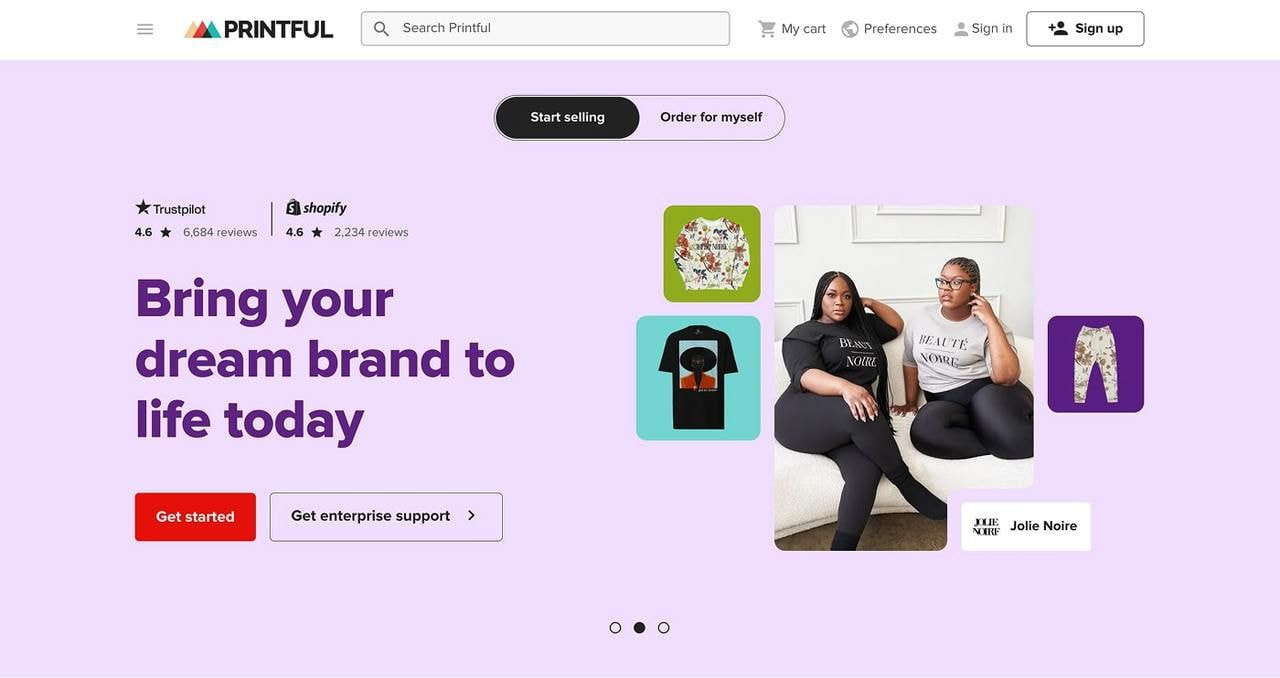
Printful is a leading POD platform helping artists create and sell custom products online without handling inventory or shipping.
Main features
Printful is a top POD service that allows you to turn your own art into sellable products like posters, apparel, mugs, and more. Its built-in design tools, product mockups, and integrations with platforms like Etsy, Shopify, and Amazon make it easy to run a professional shop. Many creatives use Printful to scale and build a brand without needing a studio or warehouse.
Costs
Printful is free to join. You only pay when you sell a product, with the base product and shipping costs deducted automatically. You set your own prices, staying on top of your profit margins. There’s also a Printful Growth plan that costs $24.99/month. Printful Growth unlocks VIP discounts, exclusive print placements, free digitization, and more.
Success story: UMAI Clothing scaled to six‑figure monthly sales using Anime-inspired streetwear and strategic ads using Printful’s fulfillment and support.
Tip: Explore the 17 print-on-demand niches to watch in 2026.
Printify
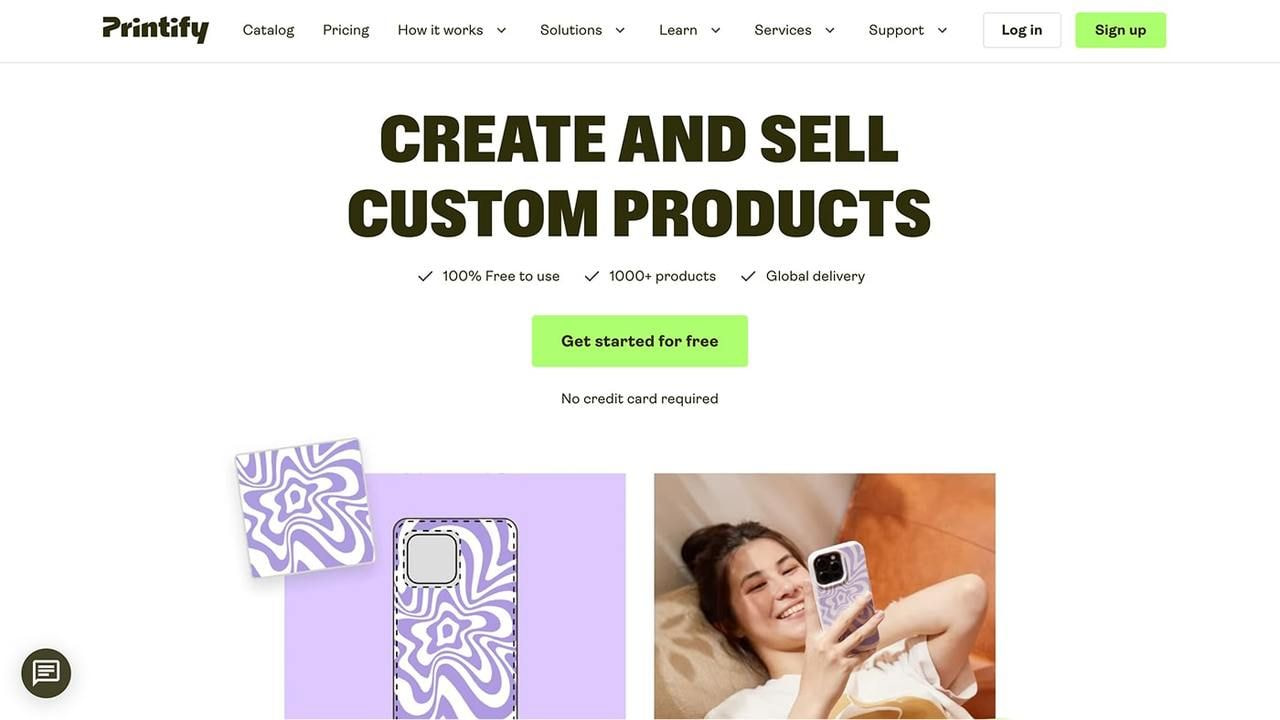
Printify is a POD platform that connects creators with global print providers, making it easy to create and sell custom products online.
Main features
Printify gives creative entrepreneurs access to a vast print partner network, allowing for flexible product options and competitive pricing. You can sell your art on everything from canvas prints to t-shirts on platforms like Shopify, Etsy, and WooCommerce. Printify’s Product Creator and variety make it ideal to test new ideas and reach different markets.
Costs
Printify offers a free plan where you only pay for products after a sale. For higher margins, a Premium plan is available at $29/month, offering up to 20% off on all products.
Redbubble
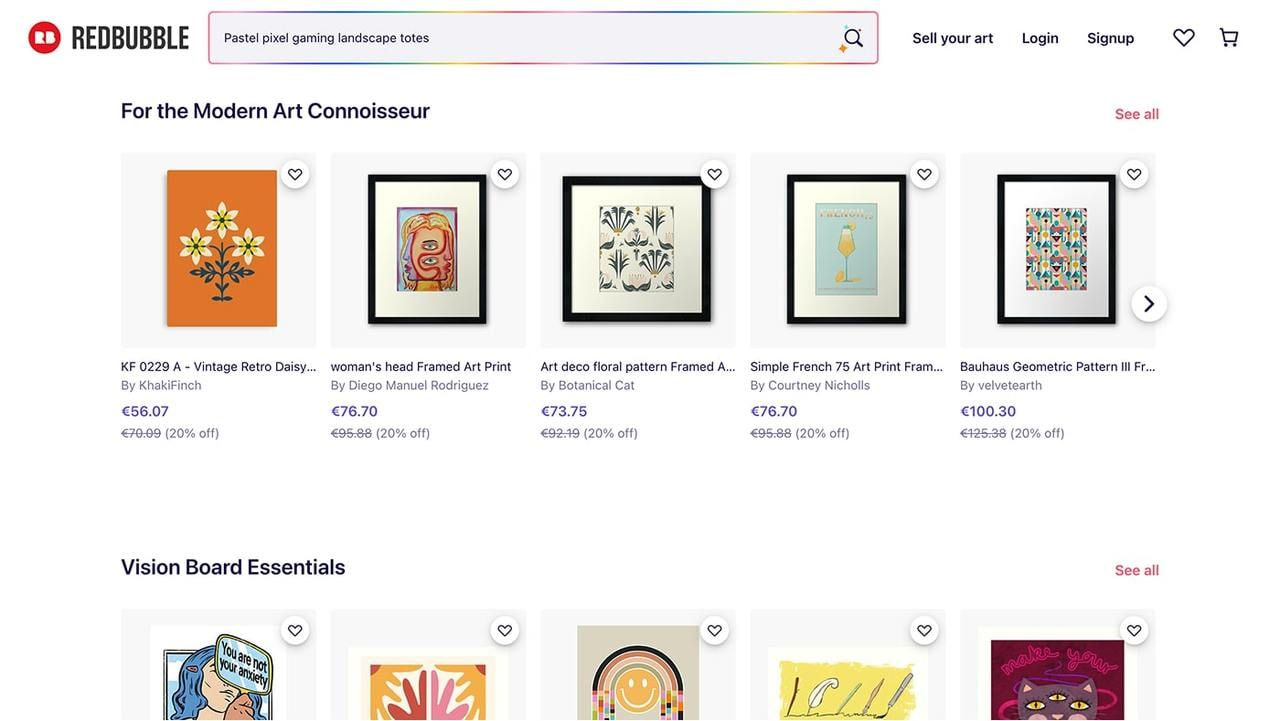
Source: Redbubble
Redbubble is a global POD marketplace where creative entrepreneurs upload designs and sell them on a wide range of products without managing production or shipping.
Main features
Redbubble is popular among illustrators, graphic designers, and digital artists looking to reach a broad audience. You can sell your art on products like prints, t-shirts, phone cases, stickers, and home decor. With a built-in community of art lovers and a user-friendly upload process, it’s a convenient way to showcase your artwork and connect with customers worldwide.
Costs
Redbubble is free to use. You earn a base commission (typically around 10–20%) on each sale. But you can set your own markup for art prints and other products to boost earnings. The platform handles all fulfillment and customer service.
Fine Art America
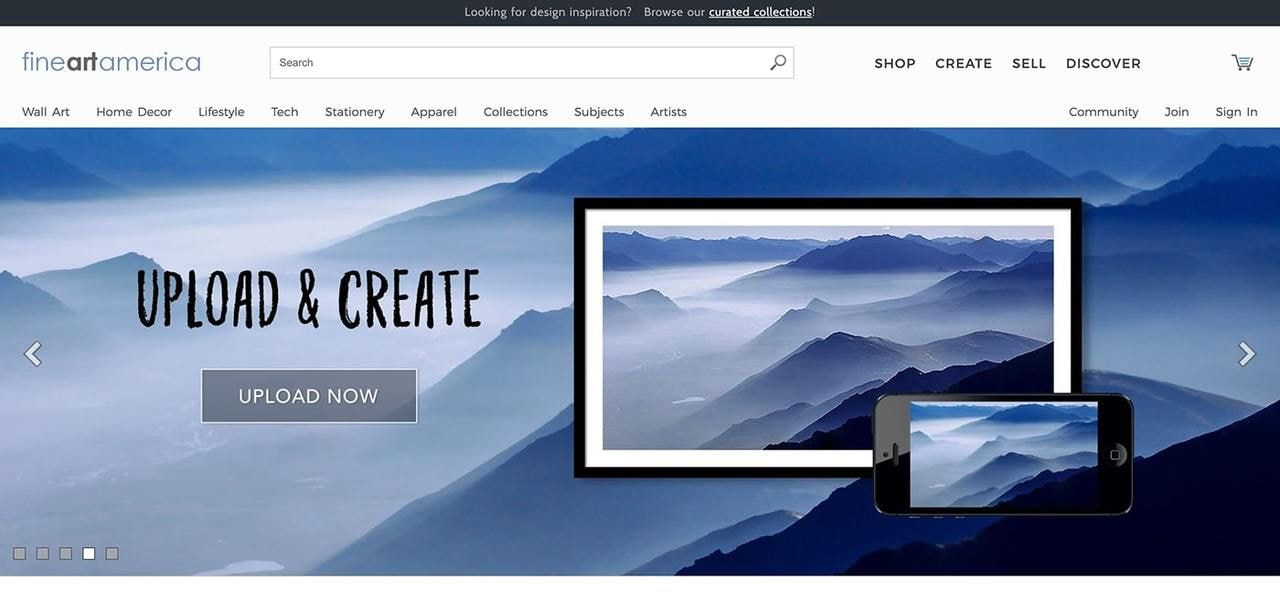
Source: Fine Art America
Despite the name, Fine Art America serves a global audience, allowing creators to sell their work worldwide. Its sister site, Pixels, offers similar services with an even broader international focus.
Main features
Fine Art America is explicitly tailored to creatives who want to sell items like wall art, home decor, apparel, and digital art.
This print-on-demand platform includes useful features that assist with marketing and promotion, including customizable artist profiles, marketing tools, and social media integrations.
Costs
Fine Art America offers two membership options—a free plan with limited features and a premium plan at $30/year. Creators set their own prices, taking complete control over how they market and sell their work.
Read more: Fine Art America vs. Printful: Artist Profitability Comparison
Online marketplaces
Etsy
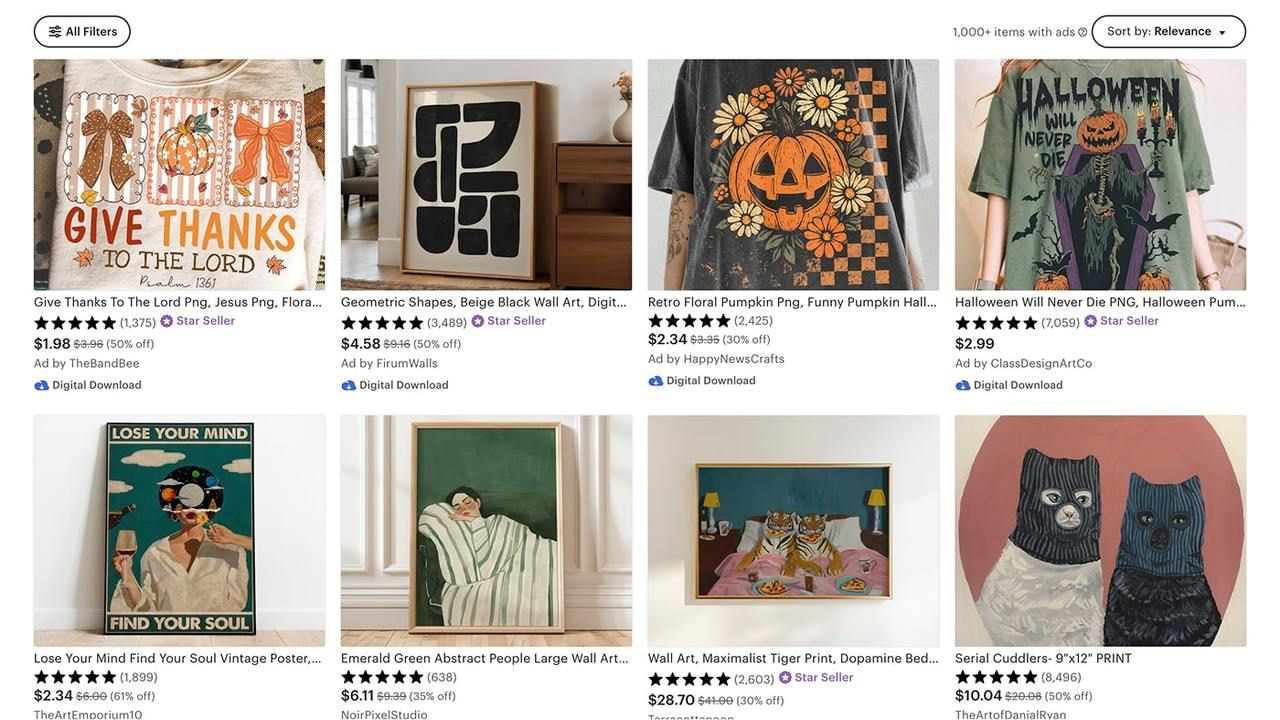
Source: Etsy
Etsy has established itself as a top platform for artists and crafters to sell handmade products. It’s known for its community-centric approach and user-friendly interface, making it suitable for beginners and seasoned sellers.
Main features
Etsy has a massive art subcategory where you can sell different types of art like prints, paintings, and illustrations. Etsy’s top sellers range from illustrators and jewellery makers to vintage curators, all tapping into the platform’s large and engaged customer base.
With complete ownership of pricing and inventory, artists tailor their shops to suit their brand and scale their business on their own terms.
However, Etsy is a competitive space for original work. Sellers must go the extra mile to drive traffic to their listings through social media marketing and advertising.
Costs
Etsy charges a $0.20 listing fee per item and a 6.5% transaction fee on the sale price, which includes the shipping cost. These fees can add up, especially if sales are slow, as the listing fees are incurred whether or not you make a sale.
Success story: Rose Gold Rebel grew from under $200/month to almost $1 million in revenue by 2018, ranking among Etsy’s top 100 sellers with cheeky designs.
While the platform’s design tools are limited, and fees add up, many sellers see value in the trade-off. They gain visibility and access to a niche audience actively seeking out handmade and authentic items.
Pro tip: Explore Printful’s complete guides on how to sell art on Etsy and how to sell prints on Etsy.


Saatchi Art
Established in 2006, Saatchi Art offers over 1 million listings from 90,000 creators, becoming a leading destination for art enthusiasts and collectors.
Main features
With millions of monthly visitors, the platform is a top destination for selling art. It connects artists directly with customers, offering everything from paintings and prints to mixed media and digital works across diverse styles and genres.
Costs
Saatchi Art takes a 40% commission on sales—lower than traditional galleries’ typical 50% cut. This allows creatives to keep a larger share of their earnings while still reaching a global audience.
Success story: Sandy Dooley, a London painter, says that Saatchi Art “opened doors” to a massive audience of art lovers, enabling new sales and growth.
Amazon Handmade
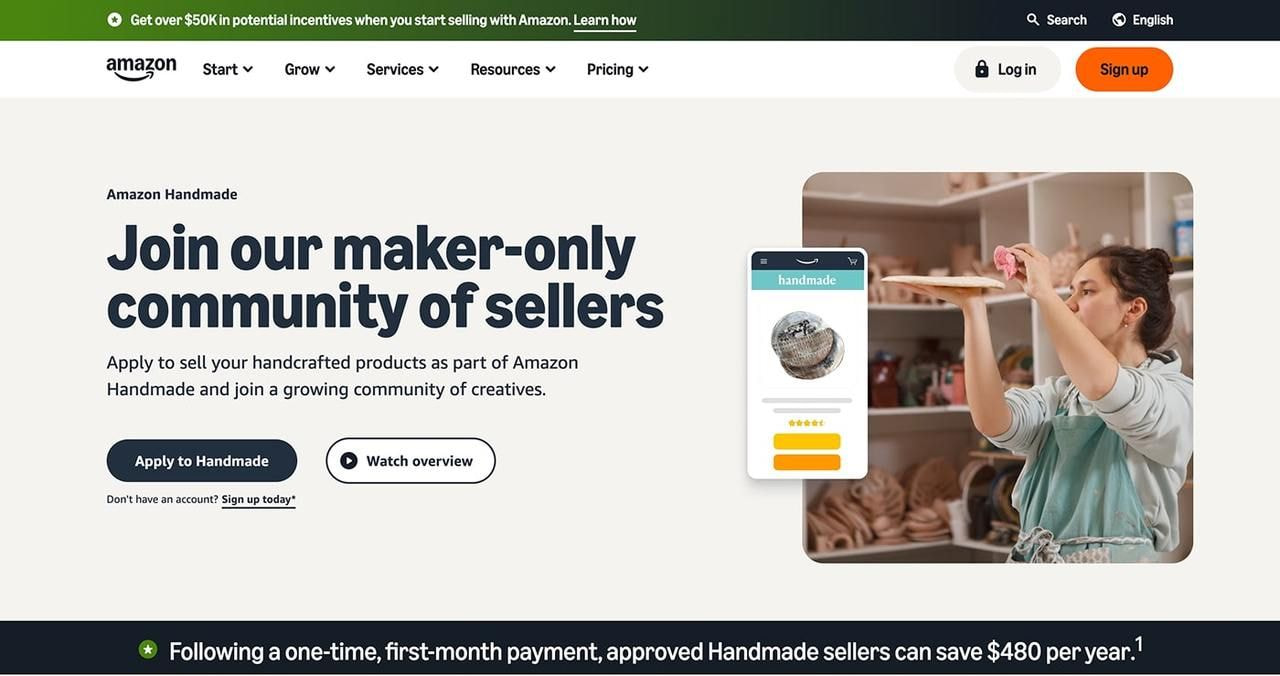
Source: Amazon Handmade
Amazon Handmade provides a marketplace for selling handcrafted goods, including art, on the world’s largest ecommerce platform. This dedicated section of Amazon’s website is specifically for online sellers of homemade art.
Main features
Sellers must apply and be approved to access Amazon Handmade’s major customer base. The platform reviews each application to ensure that products are original, high-quality, and meet its handmade standards.
Costs
Amazon Handmade charges a flat 15% referral fee per sale, with a $1 minimum. The simple, transparent fee structure means no hidden costs—just a clear cut taken from each transaction.
Want to learn more? Here’s how to sell art on Amazon.
eBay
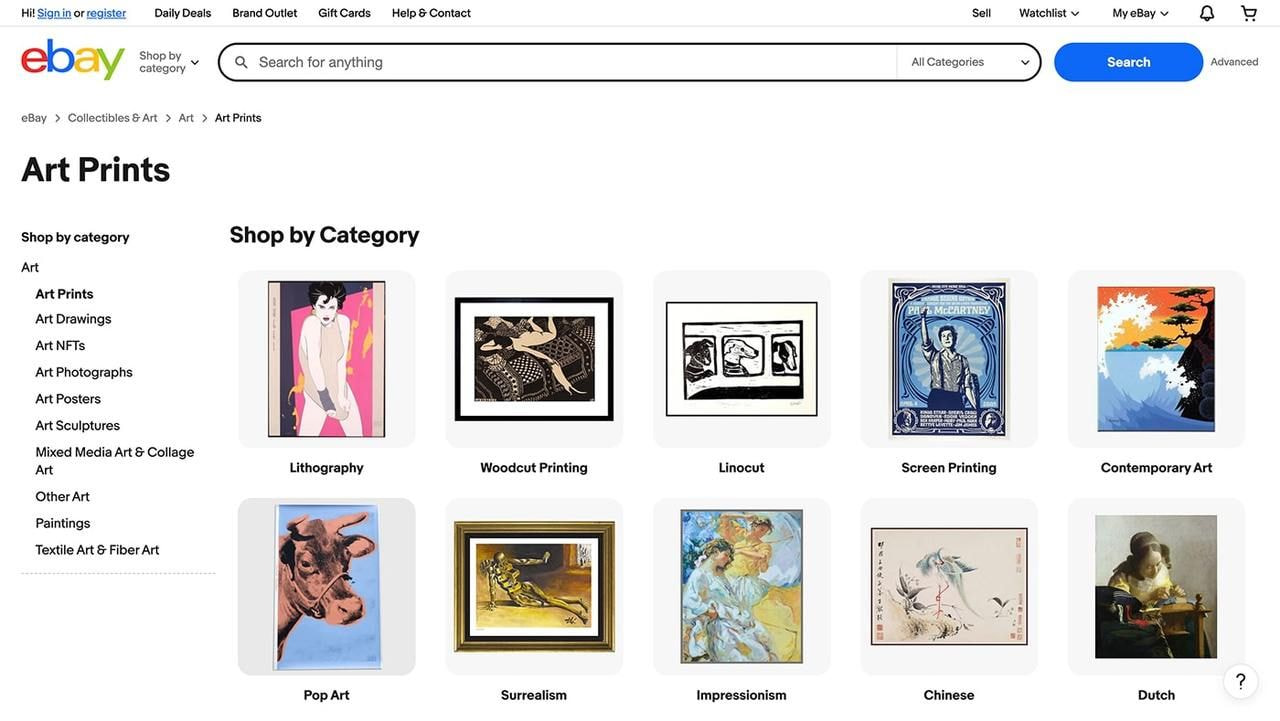
Source: eBay
eBay, one of the world’s largest online marketplaces, is a solid option for artists selling original work, prints, or even NFTs. With a seller account, you can list your art in dedicated categories and reach a global audience.
Main features
The platform includes a dedicated section called eBay Art, which features photographs, drawings, prints, paintings, sculptures, posters, and NFTs.
You can list your art as an auction with a minimum price or use Buy It Now to sell immediately. Auctions sometimes lead to higher prices, making eBay a good place to test demand and reach new buyers.
Costs
eBay charges a final value fee, which includes shipping costs. Final value fees vary per category, with art being charged 5% per sale. However, with its policy of zero insertion fee listings, the platform allows creators to list up to 250 items a month without any additional costs.
For more insight, check our in-depth blogs on how to sell art on eBay and how to increase eBay sales.
Artfinder
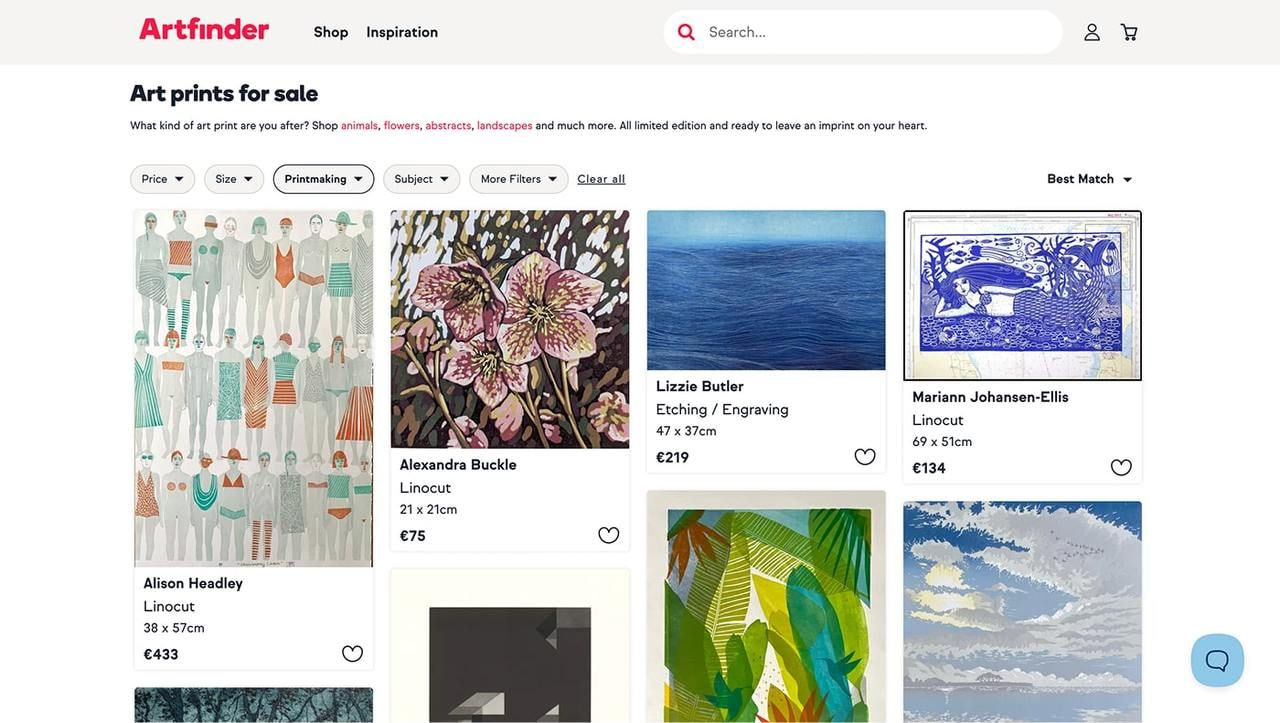
Source: Artfinder
Artfinder is a curated online marketplace that connects independent creators with collectors looking to buy art directly.
Main features
Artfinder is perfect if you’re a painter, photographer, or other creator and want to sell your art in a personal and professional setting. Each shop is carefully reviewed before being accepted, ensuring a high-quality community of creatives.
The platform focuses on original pieces—no prints or mass-produced items—making it a strong fit for those offering one-of-a-kind artwork from their studio. It’s also a great place to discover how other artists present and price their work in today’s market.
Costs
To join, artists must apply and be approved. Once accepted, Artfinder offers three plans:
-
Starter plan—free with a 45% commission and allows up to 30 artworks
-
Standard plan—$5/month with a 40% commission and unlimited listings
-
Professional plan—$12/month with a 40% commission and unlimited listings
Ecommerce platforms
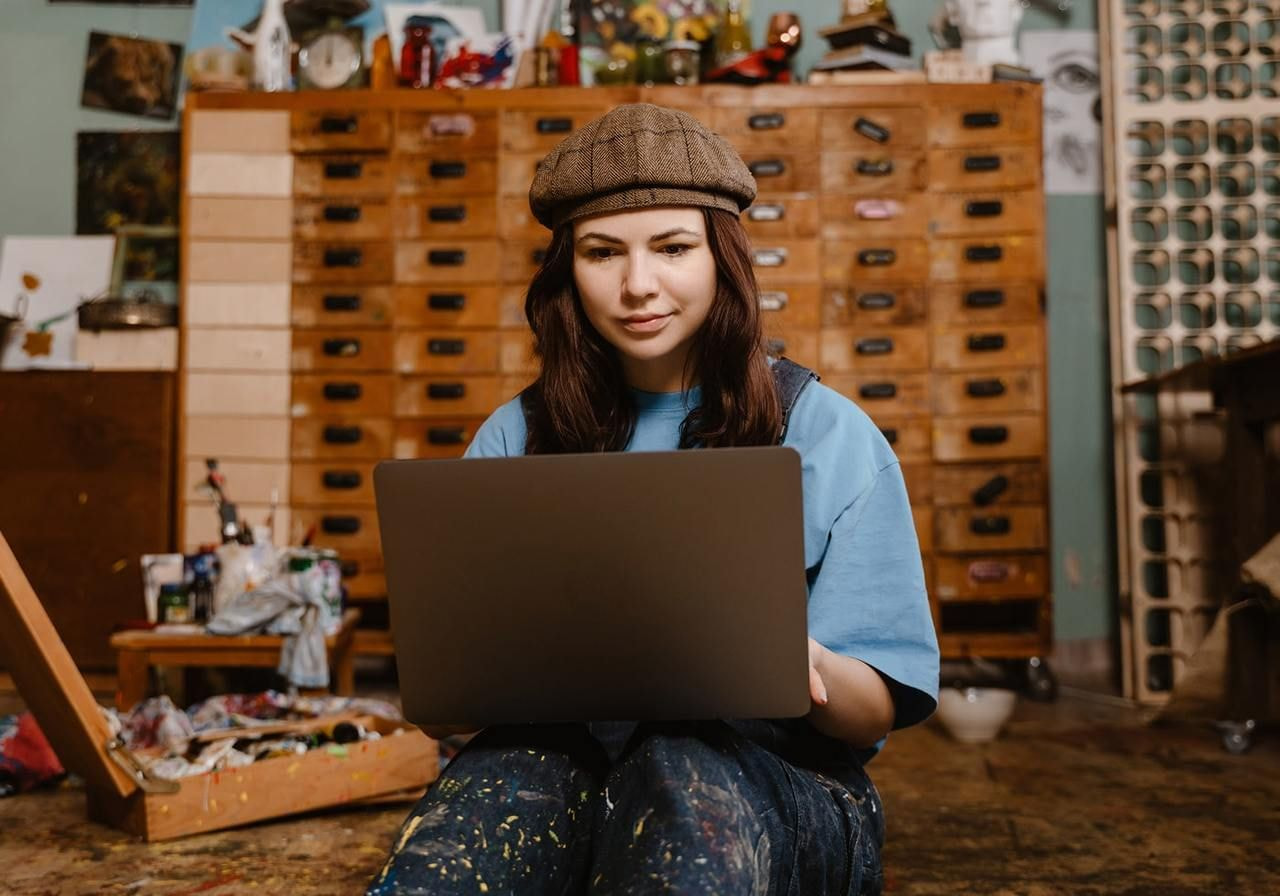
Shopify
Shopify is an ecommerce platform that provides artists with all the tools necessary to build their own online store—from website design and product listings to payment processing, marketing tools, and order management.
Main features
Customize your store with templates, social media integrations, and apps that expand its features. Shopify’s built-in analytics help you track performance and grow your business.
Read more:
-
Explore Printful’s article on the 16 best Shopify apps for your ecommerce store
-
See 7 top tips on how to increase Shopify sales
Costs
Shopify plans start at $29/month, with additional transaction fees if you don’t use Shopify Payments. While it costs more than other platforms, it gives you more control, flexibility, and professional growth tools.
Success story: Jamie Koala Art & Design sells her art and jewelry via Shopify since 2009, reaching a global audience through a fully integrated online store.
Wix
Wix is a flexible website builder that lets you create a custom online shop to showcase and sell your art without coding skills.
Main features
With drag-and-drop design tools, built-in ecommerce features, and beautiful templates, Wix is ideal for artists looking to launch a professional site. Upload original art, set pricing, run promotions, and add galleries to highlight new collections or behind-the-scenes content from your studio. Wix also offers SEO tools and marketing integrations to help drive customers to your shop.
Costs
Wix offers four paid plans suitable for selling art online:
-
The Light plan—$17/month
-
Core—$29/month
-
Business—$39/month
-
Business Elite—$159/month
Woocommerce
WooCommerce is a powerful WordPress plugin that turns your website into an ecommerce shop, giving you full control over how you sell your art online.
Main features
WooCommerce is ideal for artists familiar with WordPress. You can customize every part of your store—from listings and design to inventory, payments, and promotions.
It supports print collections, digital downloads, and original pieces, along with built-in tools to manage sales, marketing, and analytics.
Costs
WooCommerce is free, but you may need to pay for hosting, premium themes, or additional plugins. There are no platform fees, so you keep all your profits, making it a smart option for artists who want maximum control over their store and earnings.
Art-specific platforms
Getty Images
Getty Images is a top platform for licensing and selling digital art and photography, widely used by brands, publishers, and marketers.
Main features
If you’re a photographer, illustrator, or digital creator, Getty Images offers a professional way to sell your art through licensing. You upload high-quality images or digital files and earn royalties every time someone makes a purchase.
It’s best for artists focused on commercial use, not individual collectors.
Costs
You must apply and be approved to join Getty’s contributor program. Payouts vary based on licensing terms and exclusivity, but artists earn a percentage of every purchase. It’s a smart option if you want to monetize your work at scale and reach global buyers.
Singulart
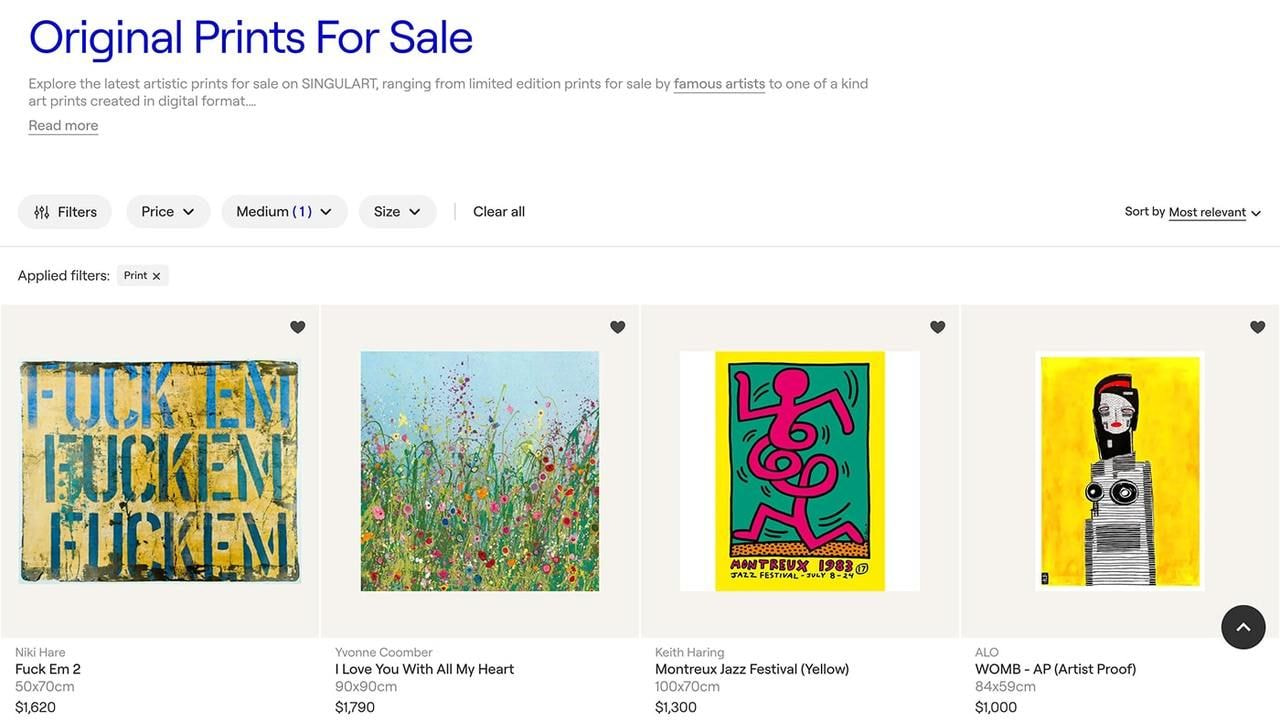
Source: Singulart
Singulart is a curated web gallery where collectors buy art from established and emerging creators worldwide.
Main features
Singulart focuses on high-quality, original art, ideal for selling paintings or large-scale pieces. Each artist gets a personal profile to showcase their work, pricing, and story. The platform attracts serious collectors, international galleries, and buyers seeking contemporary art.
Costs
To join, you must apply and be reviewed by Singulart’s curatorial team. The platform takes a commission on each purchase, but handles logistics, shipping, and client communication. It’s a strong choice for anyone looking to position their work in a premium online market and explore new career growth ideas.
ArtPal
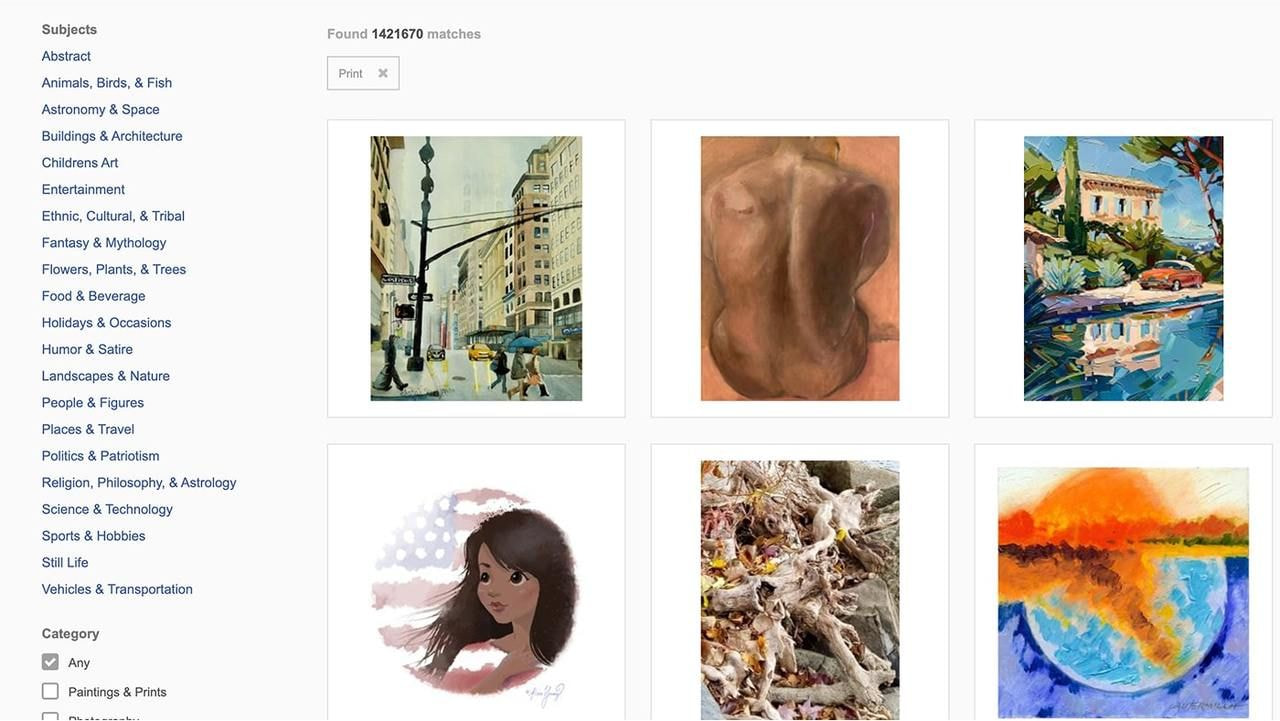
Source: ArtPal
ArtPal is a popular US-based online marketplace founded in 2011, which connects 300K+ artists with art enthusiasts and collectors worldwide.
Main features
The platform features a diverse artwork gallery, including paintings, ceramics, sculptures, photography, and jewelry. Artists sell original work directly to buyers, which makes ArtPal a strong platform for gaining exposure and building a portfolio.
The platform includes artist profiles, galleries, and a secure checkout system, making the buying and selling experience smooth for both sides.
Costs
ArtPal offers a completely free platform for artists to sell their art, with no membership fees or commission charges.
Society6
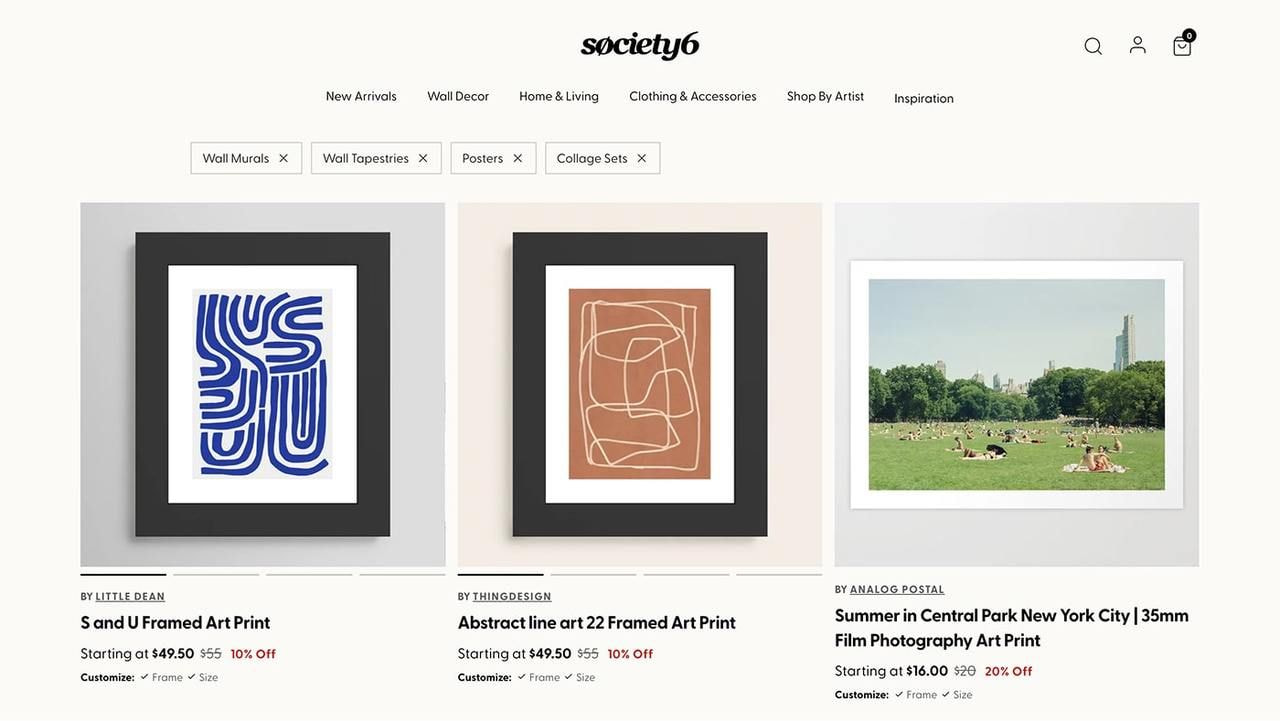
Source: Society6
Society6 is an American online marketplace and a print-on-demand service that allows artists to sell prints of their work on various products, including posters, phone cases, pillows, and mugs.
Main features
Artists on Society6 set their own profit margins for art prints, framed prints, and canvases, allowing them to earn more based on their custom markup. Artists earn a standard 10% commission per sale for all other products.
The platform’s extensive reach and product variety make it a popular place to sell art online, but artists must actively promote their work to stand out.
Costs
Society6 offers a user-friendly solution with no monthly fees. Prices on the marketplace are determined by the base price (set by Society6) + the markup (set by the artist). Artists typically make a 10% commission on sales, but they can increase their revenue by setting higher markups for specific items and participating in the platform’s affiliate program.
Although the commission structure might not be the most lucrative compared to other platforms, Society6 offers a straightforward way to get your art in front of a broad audience.
Read more: Comparing Artist’s Profit on Society6 vs. Printful
Other options
Instagram is an artist-favorite platform to exhibit and sell artwork, thanks to its visually oriented interface and extensive user base.
Selling through a basic Instagram Shop—where you tag and link products—is completely free. However, if you enable Instagram Checkout (in-app purchases), Instagram applies a 5% selling fee per shipment (or a flat $0.40 fee for orders of $8 or less).
Read more: Selling on Instagram vs. Etsy: What’s Right for You in 2026?
With unique visual search engine capabilities, Pinterest is an excellent platform for artists to showcase and sell their work at no cost.
Selling on Pinterest is 100% free—you won’t pay any fees to set up a business account, list products, or have users shop your Pins.
The only costs come if you choose to advertise. Pinterest’s ad model is auction-based, meaning you set your own budget and typically pay $0.00–$0.20 per click, or around $2–$5 per 1,000 impressions.
Tip: Check out our ultimate Pinterest marketing guide to learn how to promote your brand.
Fair markets
Fair markets and local art events are valuable spaces to connect with clients and introduce your art to new audiences offline.
These in-person venues allow you to meet customers face-to-face, share the stories behind your work, and build lasting relationships. Many customers prefer to see and feel the print or canvas before they buy art. These markets also allow you to learn from other artists, explore ideas, and test new pricing strategies.
Your own website

Building your own website lets you own every part of selling your art and presenting your brand online.
Main features
With a personal site, you can showcase original works, offer prints, and even introduce new product lines. It’s a great space to tell your story, feature testimonials, and build a direct connection with buyers. Unlike marketplaces, your website puts you in charge of design, pricing, and promotions—ideal for long-term growth and creating your brand.
Costs
Website builders like Wix or Squarespace offer affordable options with ecommerce tools. You’ll pay for hosting and a domain, but keep 100% of every sale. It’s the move for artists serious about running their business on their terms.


Create and sell art with Printful

Printful makes it easy to turn your art into sellable products—and reach customers worldwide. With seamless integrations across top ecommerce platforms and marketplaces, you can expand your reach and increase sales fast.
Here’s how to get started:
Step 1: Connect your store with Printful
-
Sign up for free with your email, Facebook, Apple, or Google account
-
Connect Printful to your business—go to Dashboard > Stores, select your preferred platform, and click Connect
Step 2: Choose your favorite product
Now that your account is all set up, it’s time to pick a product.
Here are some of the most popular options:
Posters and canvas
Posters and canvas prints are great for graphic designers and painters—affordable, easy to ship, and popular with buyers looking to decorate their spaces with unique art.
Home decor
Turning your art into home decor—like pillows and blankets—establishes you in a growing market. These functional items are popular for home makeovers and thoughtful gifting.
Stickers
Custom stickers are a budget-friendly option that appeals to a broad audience. They’re decorative items that double as portable ads, showcasing your artwork on everyday objects like laptops and water bottles.
Custom clothing
Custom clothing like t-shirts and hoodies turns your art into wearable designs. With space for bold prints, they’re a versatile way to reach style-conscious customers.
Step 3: Create your designs
After picking the product to feature your artwork, up next is prepping your designs for print.
You don’t need fancy tools or apps—just this one. Use our Design Maker to upload your art and adjust colors, size, and placement for a perfect fit. This tool makes it easy to customize and preview your design on real products.
Want more control? Prep your files in Photoshop, Illustrator, or Canva first, then upload them to Printful when ready.
Step 4: List your orders
When listing your products, use clear, engaging titles and descriptions that reflect the value and style of your art. This sets expectations and reduces confusion during sales.
Create a visually appealing storefront that highlights your work and apply basic SEO tactics to boost visibility and attract more organic traffic.
Final Thoughts
So, what are the best places to sell art? There’s no one-size-fits-all answer. The right platform depends on what you create and how you want to sell it.
Smart artists use a mix of tools: marketplaces for traffic, ecommerce sites for control, and print-on-demand for passive income. That combo gives you more freedom, reach, and ways to build a business that fits your art.
FAQs
Selling art online through your own shop, using platforms like Shopify or Etsy, paired with print-on-demand services like Printful, is highly profitable. This setup gives you more control over pricing, branding, and sales, helping many artists scale their business with unlimited space and lower overhead.
To start selling your art, create a storefront on marketplaces like Etsy or build an ecommerce site. Use high-quality product images and SEO-friendly descriptions to attract customers. Integrate with print-on-demand to sell prints, digital art, or custom products like apparel and home decor.
Art prints sell well because they’re easy to reproduce and scale. Digital art and contemporary styles are also popular, especially when priced to reach a wider audience.
Absolutely. Etsy’s a great place to sell art, especially for those creating prints, stickers, or handmade goods. Its large, built-in community of art lovers helps many artists find customers without a personal website.
The best market depends on your goals. Platforms like Etsy and Shopify offer scale and ease of setup, while local art galleries, coffee shops, and partnerships with local businesses build in-person connections and brand recognition. Combining online and offline strategies works the best for many artists.



Printful is an on-demand printing and fulfillment service that helps businesses create and ship custom products.





